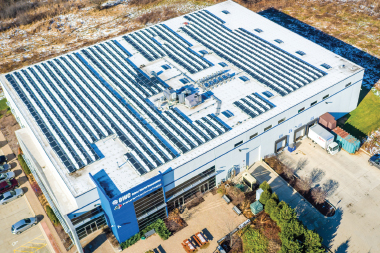
INSIGHTFUL CONVERSATIONS... START HERE
Harnessing The Sun’s Power

Today, converting light into useable energy is big business.
Just ask Peter Hardt of Hardt Electric, Inc. of Chicago. His company recently installed a large solar powered roof system for Other World Computing (OWC) in Woodstock, IL, a supplier of products for Apple Computers and other mobile devices.
“There really is a market,” says Hardt. “People are serious about it and there are lots of consumers who want to incorporate it into their organizations. There is solid Return-on-Investment.”
Installation of the SunPower X21-345 photovoltaic modules presented Hardt and his team with challenges.
“Typically you have to know what the building can sustain,” explains Hardt. “There’s the framing, aluminum, cinder blocks, the whole bracket. There’s engineering involved on the structural side, and people have no clue how important these details are or how they come into play.”
Over a period of eight weeks, the project team of six added a total weight of 50,000 pounds, spread over 20,000 square feet of roof. That equals 2.49 pounds per square foot of additional dead-load weight to the structure. With a building slope of 2.1 percent, the crew had to account for snow and drainage. Working with local structural engineers, Hardt had to take the building’s tolerances into consideration.
“We had to meet the requirements of the roof and make sure the racking system would work well on it,” he explains. “There wasn’t a lot of play to add weight on the building and safety measures are critical. Unfortunately, the majority of the people doing this type of work are not trained properly for this technology,” he says. “Some argue that you don’t need electricians to do it. But they don’t understand the risks. Training and experience becomes critical.”
To ensure the photovoltaic system was installed correctly and safely, the project team included a North American Board of Certified Energy Practitioners (NABCEP) certified installer. For many business owners wanting solar power systems, there is a comfort factor in hiring an electrical contractor who is certified by organizations such as NABCEP. The team also included local union electricians as well as Local 134 contractors.
Roofs have limitations. Because of its size and complexity, the OWC project demanded two months of preparation time and two months for installation. The racking system was designed and constructed specifically for OWC’s structural requirements.
OWC also wanted Hardt’s team to install a complex system to accurately monitor not only the solar panels, but also a wind turbine, and the building itself.
“They don’t come off the shelf ready-made,” says Hardt about the installation. “It takes time to build these things.”
This type of installation work also comes with other challenges. The more building owners want solar power systems for their roofs, the more the number of inexperienced installers also enter the marketplace. “It’s a gateway for non-union to get into the market,” says Hardt. “Competing against non-union groups is a challenge in this market, because not everyone realizes the importance of training, experience, and safety. I feel this will change over time.”
What does the future hold for solar power? For electricians who want to prosper, the future requires more learning.
Training for this industry has become a priority. For example, in September 2015, the IBEW/NECA Technical Institute in Alsip, Illinois, opened its Renewable Energy Training Field (RETF). The center provides hands-on training for electricians. Students learn to remove and reinstall solar panels, as well as work with wind generators and all aspects of battery storage. They also gain an understanding of energy-transfer systems – critical to helping customers lower peak energy costs.
Hardt sees unlimited potential with solid returns.“You make money by lowering operational costs for projects like these,” he says. “In 10-12 years the system pays for itself.”





